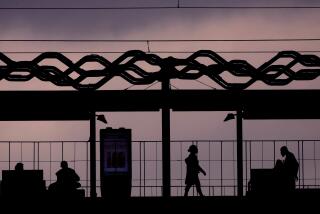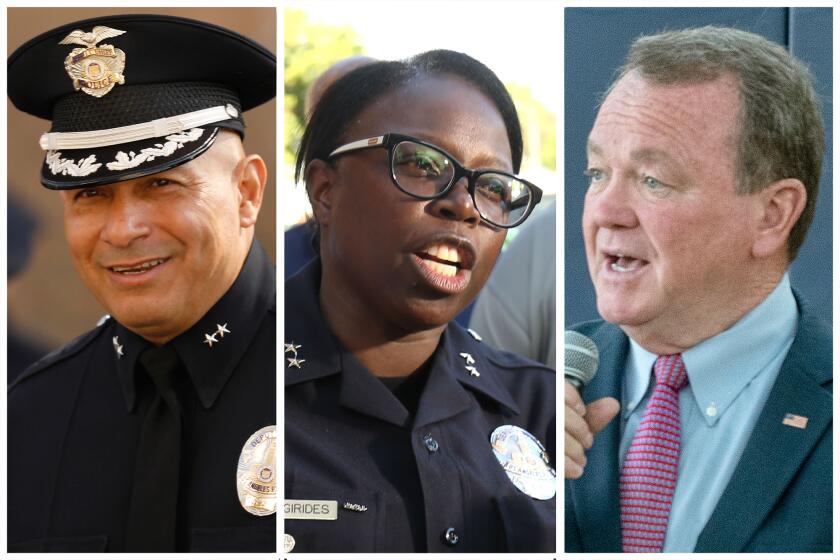Politicians Gird to Join the Fray Over Light Rail
Sometime this week, the 22 city, county, state and federal elected officials whose districts cover at least a part of the San Fernando Valley will receive something in the mail from Mayor Tom Bradley. It won’t be a Christmas card.
Instead, it will be an invitation from the Los Angeles mayor, acting in his role as chairman of the Los Angeles County Transportation Commission, to form a group to determine what light-rail route, if any, should be adopted for the Valley.
Some liken Bradley’s invitation to being asked to walk on hot coals or swallow a flaming torch. Yet, despite the risks, several of the Valley’s more ambitious politicians seem likely to jockey for leadership on the issue, creating a political free-for-all that may dim any chance for light rail.
In the face of fierce community opposition to all five routes under consideration, the transportation commission last month abandoned its three-year effort to find an east-west Valley route.
Burned by their experience with fiery Valley homeowner leaders, commissioners voted to invite local elected officials to enter the caldron in their stead.
In so doing, commissioners and homeowner leaders expressed the hope that local representatives could find that elusive route that everyone likes.
Letting the Valley Decide
The decision to turn the issue over to local officials was widely praised. Homeowner leaders particularly exhibited a near-messianic belief that letting the Valley “decide its own fate” would lead to a decision that could satisfy all.
However, a few participants in the lengthy debate over Valley light rail are convinced that nothing but friction will be generated when local elected officials take over the touchy transportation question.
Skeptics recall the folly that ensued when the eight Los Angeles City Council members from the Valley attempted a year ago to form a regular discussion group on Valley issues.
The plan collapsed amid disagreements over who would call the meetings, where the meetings would be held and whose idea the caucus was in the first place.
Despite the political risks inherent in the light-rail debate, state Sen. Alan Robbins (D-Van Nuys), Assemblyman Richard Katz (D-Panorama City) and City Councilmen Zev Yaroslavsky and Hal Bernson will probably seek a commanding role on the issue.
Robbins, author of a state law that controls when and how Metro Rail will be built in the Valley, has long viewed himself as the Valley’s chief spokesman in Sacramento.
In September, he introduced a bill that would have banned light rail from parts of North Hollywood and Van Nuys. The bill would have killed two routes under study that connect North Hollywood with Warner Center--one route that follows Chandler and Victory boulevards and one that largely follows Victory the length of the Valley.
After passing the Assembly, the bill stalled in the Senate just before the Legislature adjourned in September. Robbins says he plans to revive the bill, which was co-sponsored by Assemblyman Tom Bane (D-Tarzana), in January.
Other routes that had been under consideration by the county Transportation Commission are the Southern Pacific railroad main line, the Ventura Freeway and the Los Angeles River.
While there was some opposition to all five routes, the two singled out in Robbins’ bill traverse long-established residential neighborhoods and drew the most wrath.
Katz, who is said to be considering a run for county or city office, is chairman of the Assembly Transportation Committee and has sought a high profile on transportation issues in recent years.
He co-sponsored with Robbins legislation that would have merged the county Transportation Commission, which is building a countywide network of trolley lines, and the Southern California Rapid Transit District, which is building Metro Rail in addition to operating buses.
The bill passed the Legislature but was vetoed by Gov. George Deukmejian in October.
Katz and Robbins, whose rivalry in Sacramento has led to a strained working relationship, say they probably will push a new merger bill in January.
Bernson, a northwest Valley councilman who by most reports is not yearning for higher office, has nonetheless staked out a leading position on transportation issues by taking over chairmanship of the San Fernando Valley Area Transportation Study Committee, a 50-member group created by the Legislature to propose solutions to the Valley’s traffic problems.
The committee was created in response to a 1983 study by the Southern California Assn. of Governments, which concluded that the Valley faces worse congestion by the turn of the century than any other area in the Southland.
Bernson said he views the commission’s pullback from the Valley light-rail issue as an opportunity to push his own solution to gridlock--an upper deck on the Ventura Freeway with a light-rail line incorporated in the design.
The upper-deck plan was endorsed in September by Bernson’s study group.
Yaroslavsky, a probable mayoral candidate in 1989, appears eager to take the high ground in the light-rail debate at the expense of Bradley, who has announced he will seek a fifth term.
He criticized the mayor and the commission for “not knowing what they wanted to do, except to drop back and punt. As a result, we on the council must take a leadership role.”
Had Ample Representation
Five of the 11 commissioners--Bradley, Van Nuys businesswoman Marcia Mednick, Councilman Michael Woo and Supervisors Ed Edelman and Mike Antonovich--represent Valley constituencies, Yaroslavsky noted, suggesting there was “ample representation, so I can see no reason for the commission to abdicate its responsibility to make decisions on these matters.”
Yaroslavsky already has sought to preempt Bradley on the issue by introducing a motion in the City Council to form a 24-member group to select a light-rail route.
Each of the Valley’s eight council members would name three to the committee.
Unlike the county Transportation Commission’s proposal contained in Bradley’s letter, the Yaroslavsky plan would exclude county, state and federal legislators from the process.
Robbins, in a move reminiscent of the futile debate over formation of a Valley council caucus, quickly took issue, saying that Yaroslavsky, whose district was expanded north of the Hollywood Hills into Sherman Oaks 15 months ago, “apparently isn’t familiar with how we do things in the Valley.”
He said he would oppose Yaroslavsky’s motion unless the council members “want to create another committee of 24 appointed by state legislators.”
But on Friday, Yaroslavsky’s plan was left in the air as the council rushed to adjourn its last session of the year. His motion was referred to the council’s Transportation and Traffic Committee after Woo, who represents Studio City, announced he wants to expand its membership to include all other legislators.
More to Read
Sign up for Essential California
The most important California stories and recommendations in your inbox every morning.
You may occasionally receive promotional content from the Los Angeles Times.










